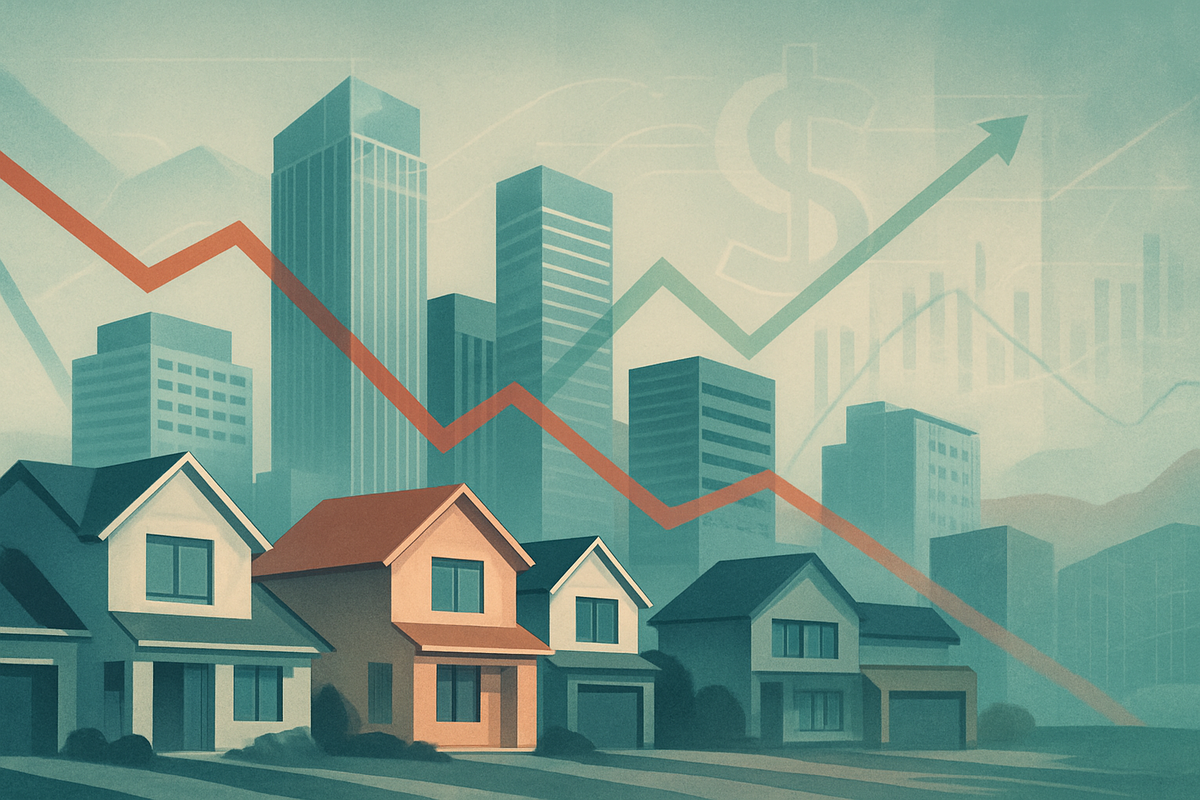
The global real estate market is currently experiencing a significant recalibration, marked by easing mortgage rates, increasing inventory, and a notable moderation in home price appreciation. As of November 2025, this complex interplay of factors is creating a more balanced, yet cautious, environment across both residential and commercial sectors. These evolving dynamics carry immediate and profound implications for the financial sector, particularly for banking institutions, and are poised to influence broader economic indicators such as consumer spending and investment patterns. The shift away from the rapid escalations of previous years signals a maturing market, demanding strategic adaptation from all stakeholders.
A Market in Transition: Details, Timeline, and Initial Reactions
The residential real estate market in late 2025 is characterized by a notable rise in active listings, offering buyers more choices than in recent years. This increase in inventory, coupled with a general moderation in home prices, suggests a cooling from the intense seller's markets observed previously. While national price increases have slowed, regional variations are pronounced; once-booming Sunbelt markets like Miami, Tampa, and Phoenix are witnessing price declines, while more affordable urban centers such as Chicago, Cleveland, and New York City are still experiencing gains. Mortgage rates, though still elevated compared to historical lows, have begun to ease, with the average 30-year fixed rate hovering in the 6.1% to 6.3% range, spurred by the Federal Reserve's initial rate cuts and expectations of further reductions in late 2025. This modest relief, however, has not fully rekindled buyer enthusiasm, which remains cautious due to persistent affordability concerns and high home values, especially for first-time homebuyers whose average age has now reached 40.
In the commercial real estate (CRE) sector, high interest rates continue to temper deal volumes, pushing investors towards properties with stable cash flow and strong long-term fundamentals. The industrial and logistics segments remain resilient, driven by e-commerce expansion and supply chain reconfigurations. Conversely, the office market continues its uneven recovery, grappling with hybrid work models, leading to a dichotomy where high-quality, amenity-rich properties retain value, while older, less adaptable buildings struggle, often necessitating repositioning or repurposing. The multifamily sector, however, maintains strong demand due to widespread housing affordability challenges, attracting continued investor interest and active construction pipelines. Initial market reactions reflect this caution: lending standards have tightened, with banks becoming more selective in real estate financing, and innovative financing options like Net Asset Value (NAV) facilities are gaining traction, particularly in public-to-private real estate deals, as financial institutions seek new avenues for growth and risk management.
Regulatory bodies are also closely monitoring the situation. Financial regulators, such as the Swiss Financial Market Supervisory Authority (FINMA), have expressed concerns regarding increased vulnerabilities in the mortgage sector, particularly given high per capita mortgage debt. They warn that retail banks, by virtue of their business models, face considerable risks if significant price corrections occur. This regulatory scrutiny underscores the need for robust risk management and careful modeling of financing structures across the financial industry, highlighting the interconnectedness of real estate health and financial stability.
Companies Navigating the Shifting Sands
The evolving real estate landscape presents a mixed bag for public companies, creating both winners and losers across various sectors, particularly within finance. Retail banks and mortgage lenders are at the forefront of this impact. Institutions like Wells Fargo (NYSE: WFC) and JPMorgan Chase & Co. (NYSE: JPM), with significant exposure to mortgage portfolios, face increased real estate and mortgage risks. While easing rates might slightly boost refinancing activity, tighter lending standards and the potential for regional price corrections could impact their loan origination volumes and asset quality. Conversely, banks actively moving into Net Asset Value (NAV) facilities for fund financing might find new revenue streams, as this segment is projected for substantial growth.
Homebuilders such as D.R. Horton, Inc. (NYSE: DHI) and Lennar Corporation (NYSE: LEN) face a nuanced environment. Rising inventory and cautious buyer demand could temper their sales growth, especially in regions experiencing price declines. However, the anticipated rebound in existing home sales in 2026, coupled with solid job growth, could provide a tailwind. Their ability to adapt to changing buyer preferences, manage construction costs amid potential tariff increases, and strategically price homes will be crucial. Companies specializing in luxury and super-luxury real estate, often catering to affluent buyers with strong capital liquidity, may continue to outperform, demonstrating resilience against broader market slowdowns.
In the commercial real estate sphere, Real Estate Investment Trusts (REITs) are experiencing differentiated impacts. Industrial and logistics REITs, like Prologis, Inc. (NYSE: PLD), are likely to remain strong beneficiaries of sustained e-commerce demand. Office REITs, however, particularly those with portfolios of older, less adaptable buildings, may continue to struggle with vacancies and declining valuations, necessitating strategic repositioning. Multifamily REITs, such as Equity Residential (NYSE: EQR), could see continued demand due to ongoing housing affordability challenges, although a cooling rental market might moderate rent growth. Furthermore, companies providing real estate technology solutions, including AI, blockchain, and virtual tour platforms, stand to gain as the industry increasingly adopts technology to streamline operations, manage risks, and make data-driven investment decisions, enhancing productivity and efficiency across the sector.
Broader Implications and Historical Context
The current real estate market trends fit into a broader narrative of economic rebalancing following a period of unprecedented growth and low interest rates. The moderation of home prices and the increase in inventory suggest a return to more sustainable market conditions, moving away from the overheated environment of previous years. This rebalancing is a critical component of controlling inflation, as real estate often serves as a significant wealth component and an inflation hedge. While homeownership can help individuals grow wealth during inflationary periods, a significant downturn could trigger a negative wealth effect, potentially dampening consumer spending and broader economic activity by reducing collateral for borrowing.
The ripple effects extend beyond direct financial institutions. Industries reliant on housing activity, such as home improvement retailers like The Home Depot, Inc. (NYSE: HD) and Lowe's Companies, Inc. (NYSE: LOW), could see varied demand depending on regional housing market health and renovation trends. Construction material suppliers and labor markets will also feel the shifts in residential and commercial development. Regulatory bodies are increasingly emphasizing Environmental, Social, and Governance (ESG) considerations, influencing investor preferences and mandating energy-efficient retrofits and green building certifications. This trend is pushing real estate developers and investors to integrate sustainability into their strategies, potentially creating new market segments and challenges for those slow to adapt.
Historically, periods of rising interest rates and increased inventory have often led to market corrections. The current scenario, however, differs from past crashes due to generally strong homeowner equity and lower overall mortgage delinquency rates. While foreclosure filings have seen a year-on-year increase, they remain within a historically reasonable range, suggesting a more controlled slowdown rather than a precipitous collapse. Comparisons to events like the UK's 1.8% average new seller asking price fall in November 2012, the largest since then, highlight how increased property choice can influence pricing. The current global economic resilience, albeit with modest growth and persistent inflation, coupled with a softening labor market, creates a complex backdrop for central banks attempting to navigate monetary policy without stifling growth.
What Comes Next: Pathways and Possibilities
Looking ahead, the real estate market is poised for a period of continued adjustment and adaptation. In the short term, the easing of mortgage rates, even if gradual, is expected to provide some relief to buyers, potentially stabilizing sales volumes. However, affordability challenges will persist, particularly for first-time homebuyers, until a more significant correction in prices or a substantial increase in wages occurs. The commercial sector will likely continue its bifurcation, with prime, amenity-rich properties retaining value while older, less adaptable assets face ongoing pressures for repositioning or repurposing. The growth of specialized financing mechanisms like NAV facilities will also continue to be a significant trend in the financial markets.
Long-term possibilities include a more robust rebound in the residential market, with the National Association of Realtors (NAR) forecasting a significant increase in existing home sales in 2026, supported by solid job growth and further mortgage rate moderation. This rebound, however, is contingent on the Federal Reserve's monetary policy and broader economic stability. Strategic pivots will be essential for developers and investors, emphasizing data-driven decision-making, technological integration (including AI and blockchain for risk management and efficiency), and a strong focus on ESG compliance to meet evolving market demands and regulatory pressures.
Market opportunities may emerge in specific segments, such as affordable housing initiatives, sustainable building projects, and specialized commercial properties catering to niche demands (e.g., data centers, life sciences facilities). Challenges will include managing construction costs, navigating regional economic disparities, and addressing the ongoing supply-demand imbalances in certain areas. Potential scenarios range from a "soft landing" where the market gradually rebalances without significant distress, to more pronounced regional corrections in overvalued markets, requiring careful monitoring by investors and policymakers alike. The interplay of global economic conditions, domestic employment figures, and central bank actions will largely dictate the trajectory of the market in the coming months.
A Comprehensive Wrap-Up: Navigating a Nuanced Market
In summary, the real estate market as of November 2025 is undergoing a significant and necessary recalibration. Key takeaways include rising inventory, moderating home prices with notable regional variations, gradually easing but still elevated mortgage rates, and a cautious buyer sentiment. The commercial sector continues to differentiate, with strong performance in industrial and multifamily properties contrasting with ongoing challenges in the office market. These shifts have immediate and profound implications for financial stocks, particularly banks and mortgage lenders, which face increased risks but also opportunities in specialized financing. Homebuilders and REITs will experience varied impacts based on their regional exposure and asset class.
Moving forward, the market appears to be heading towards a more balanced state, albeit with persistent affordability issues. While a substantial rebound in sales is anticipated for 2026, the path will likely be characterized by continued regional variations and the need for strategic agility from all participants. Investors should closely watch for further movements in interest rates, regional economic performance, and the adoption of new technologies and ESG standards within the real estate sector. The resilience of homeowner equity provides a buffer against a severe downturn, but selective investment and robust risk management will be paramount.
Ultimately, the current real estate environment underscores the interconnectedness of housing, finance, and the broader economy. It's a market in transition, demanding careful analysis and strategic foresight. Those who can adapt to the evolving landscape, embrace technological innovation, and prioritize sustainable practices will be best positioned to navigate the opportunities and challenges that lie ahead.
This content is intended for informational purposes only and is not financial advice






